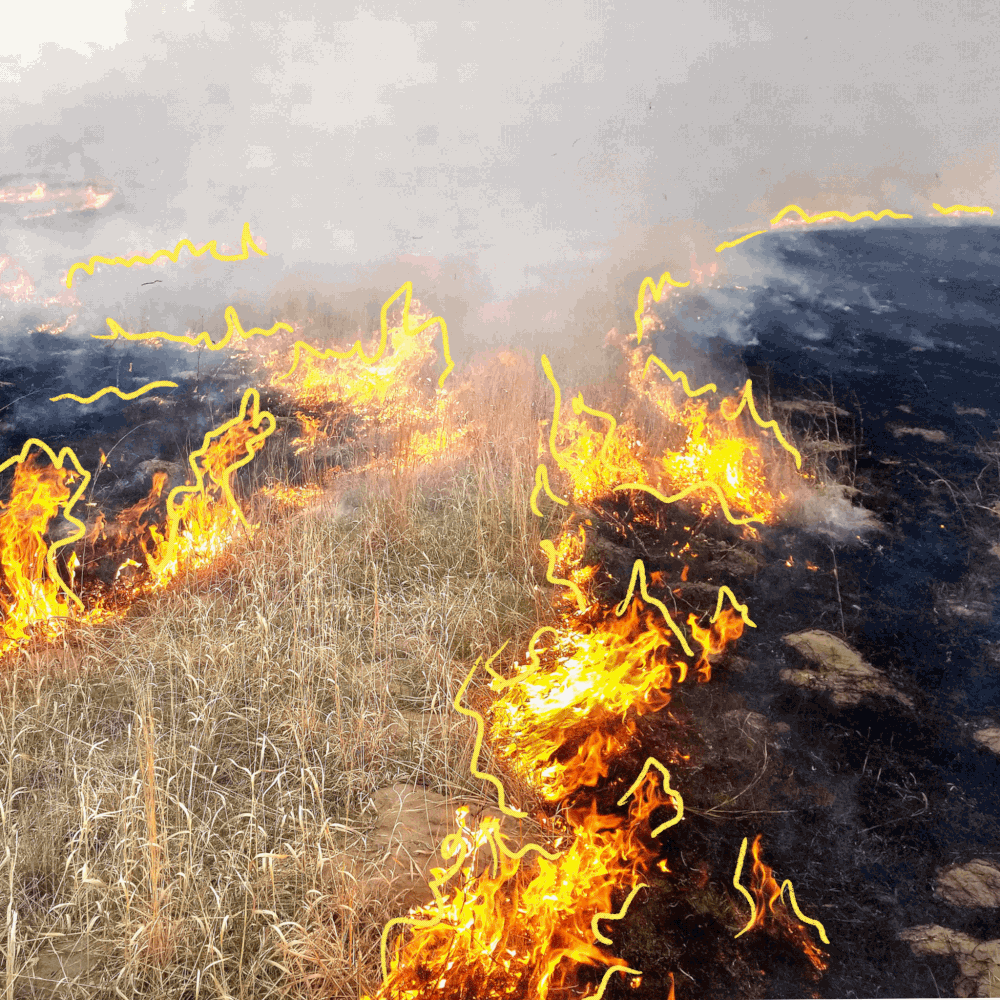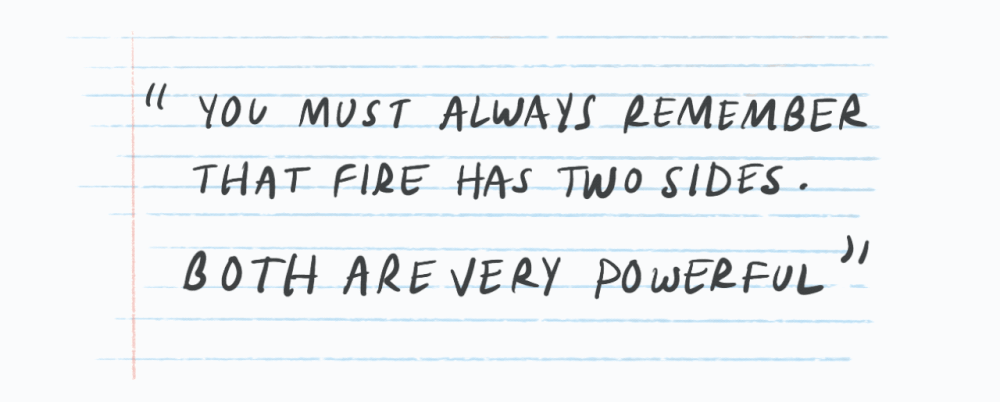“‘You must always remember that fire has two sides. Both are very powerful. One side is the force of creation. Fire can be used for good—like on your hearth or in ceremony. Your own heart fire is also a force for good. But that same power can be turned to destruction. Fire can be good for the land, but it can also destroy. Your own fire can be used for ill, too’”
Robin Wall Kimmerer, Braiding Sweetgrass
by Leah Palmer, TNC Writer/Editor
Illustration by Erica Simek Sloniker, Visual Content Specialist, TNC Washington
Early in her career, Sami Schinnell, Cooperative Fire Director at TNC in Washington, and her teammates scorched ground in the middle of nowhere, a routine maintenance of lands. From the distance, her boss called, “Hey Sami! Take the drip torches and go light the other side of the road.” Sami was confused because the road offered a boundary for spreading fire. She wondered about her responsibility to keep some of the land intact. After the burn, she asked her boss about his instructions. She remembers him saying, “A hundred years ago, that road wouldn’t have been here. It wouldn’t have been a barrier to fire spreading. Naturally, fire would have burned through here.” Her boss was speaking the language of old, when the human relationship to fire was in balance, less restricted and fueled by healthy respect.
After decades of implementing suppression policies that approached fire with fear, wildland firefighters in the United States, like Schinnell, find themselves seeking a more balanced relationship between Earth and fire. Schinnell joined TNC in Winter of 2022, and I sat down to talk with Sami about her work with prescribed burning.
Illustration of Sami Schinnell by Erica Simek Sloniker, Visual Content Specialist, TNC Washington
You’re a veteran firefighter, with 26 seasons of both fire suppression and prescribed burning under your belt. How did you come to use fire as a means for land stewardship and restoration?
I didn’t have a career in mind when I started as a wildland firefighter. The job checked some boxes—making some money and being active. It quickly became somewhat of an addiction, I would say. There’s a draw to the adrenaline of being around fire. I love the ability to work hard with a group of people for a common goal. I love the camaraderie, the hard work and sleeping face down in the dirt. After working in fire suppression for a while, I soon realized my core value was more aligned with forest ecology. I was introduced to prescribed fire when I began working for the Forest Service, and I figured out prescribed burning is the thing I want to do.
Credit: Sami Schinnell
Did you say addiction? What do you mean by that?
Well, yes. I mean that in the most positive way possible. Think about when you sit around a campfire. How often you are fully mesmerized by it? If you’re like me, you could just stare into that thing all day. It’s all consuming and helps me be present. Granted, a campfire is a much different than a wildfire or prescribed fire. Either way, it draws you in—whether it’s small or when it is multiplied across thousands of acres.
That’s so relatable! Tell me; how did you become connected to TNC, and what’s exciting about your current position?
In 2009, I went to a Prescribed Fire Training Exchange (TREX) in Nebraska. TREX trainings began with The Nature Conservancy. Jeremy Bailey, Director of Prescribed Fire Training at TNC is the father of TREX. I got to go to one of the very early classes, where I was introduced to The Nature Conservancy—its mission and prescribed fire program.
In December 2022, I began my position as Cooperative Fire Director at TNC. This means I get to support an “All Hands, All Lands” approach to utilizing prescribed fire to meet land management objectives. I get to work with all of the interested parties—from state and federal agencies, to NGOs and Tribes, to private landowners—to help connect needs to their solutions. We are trying to identify landscapes and communities that are at the greatest risk of negative impacts from wildland fires and develop action plans to help reduce those risks. It involves a lot of relationship building, training and education, site visits, and planning; it is extremely satisfying when all of that results in a safe and successful prescribed burn with partners.
Quote from Braiding Sweetgrass by Robin Wall Kimmerer; Illustration by Erica Simek Sloniker, Visual Content Specialist, TNC Washington 
Where do you think the “fire is bad” messaging comes from?
For the last 100 years, fire was considered bad, and the U.S. Forest Service’s policies suppressed fires. This caused overgrown forests because fire wasn’t doing any housekeeping. Historically, these weren’t destructive fires. They were kind of a low to moderate intensity. In dry forest landscapes, fires would come through every dozen years or so to clean things up. Elsewhere around the country, there are different “normal” fire return intervals.
Image from Smithsonian Institution Archives, depicting “a black and white cartoon print of Smokey Bear placing a Forest Service hat on Little Smokey. Little Smokey holds a bucket that says “PREVENT FOREST FIRES!” and a spade. Two singing birds are pictured next to Little Smokey.”
Another factor supporting this messaging around fire is the beloved Smokey Bear, who initially embodied collective fear of fire being used against the U.S. during World War II. At the time, there was growing concern our enemies might use forest fires to flush people out. There are multiple generations that have been taught fire is bad because of Smokey, whose tagline teaches, “you can prevent forest fires,”
So much of my work involves trying to shift that culture by educating people about the different types of fire. When people lump them all into one, nasty bucket, we’re doing disservice to forest health.
Obviously, you have to balance the values at risk here. You have to put fires out when there’s health and human property at risk, right? You can’t just let fires run rampant through towns. But, when we have natural starts in the wilderness that are, by definition, supposed to be untrammeled by humans, it’s contradictory to try and put them out.
How are you working to shift this perception of fire?
There is such a great renewed momentum to bring back and support a more balanced relationship with fire, often led with Indigenous knowledge keepers. Their ways of tending the land were outlawed for so many reasons—either because of regulations, policy, capacity or even generational loss of skills and experience. It’s really inspiring to see the conversations and the momentum behind reviving old ways of managing forests.
When I’m participating in these conversations, there’s a gardening analogy I find helpful: If a gardener were to dump all their carrot seeds in one place, and never did any maintenance, they would have overstocked them. None of the carrots are going to be healthy. There is going to be so much competition for space and nutrients that the garden will yield fewer healthy carrots. The gardener will have to thin them occasionally to let the other ones grow and become viable. The forest is similar. It needs maintenance to manage crowding, insect infestations, or other disturbances.
The exclusion of fire allows for overstocking and beetle infestations, which makes the forest more susceptible to catastrophic wildfires. It’s a cycle, right?
Credit: Sami Schinnell
I didn’t realize how connected it all was! What have you learned from these efforts to bring back cultural burning?
I spent time in Northern California with the Karuk Tribe, where historically, it was women doing burning to cultivate Hazel shoots for basketry. When you burn, the shoots are encouraged to grow longer and provide more material. At the same time, the forest is thinned, making it less prone to wildfires.
Credit: Sami Schinnell
The tribe held a training for women, and there was one of the elder-women, probably 80 years old, who came out to bless our work before we started. She talked about the importance of this. Then, during the burn, she was there watching how we were lighting and the intensity of the burn. The woman told the burn boss the fire needed to burn hotter. And he instructed us to do as she said.
This moment put things into perspective for me. In fire, we put so much emphasis on going through trainings, checking boxes and getting qualifications. And here was this 80-year-old woman who had never had formal trainings, national certifications or any of these things, and yet she was so in tune with how fire benefited the hazel shoots on this site. I was in tears.
I imagine learning from her was powerful. What is it like to witness Indigenous communities reviving cultural practices—like prescribed burning—after so long?
This is an old memory, so details are hazy, but I still want to share. One of my mentors, Scott Moats, Fire Program Manager at TNC in Iowa, shared a story from his work in Ethiopia.
Scott and his team had been working with this community for years, trying to identify the source of some issues that they were having with ticks infesting their livestock. They did all this research and eventually realized prescribed burning had been outlawed about 20 years ago, leading to trickle-down effects. And now 20 years later, they’re dealing with unhealthy livestock, which is like the lifeblood of this community. It’s where they get their food, and livestock is also their livelihood.
Scott and his team dove into changing national policy on burning. And, eventually he got to be there for the first match put to the ground in 20 years. As the village elders watched that first fire be put to the ground, they began to cry because they knew what that meant for the entire community.
Fire is a simple thing that is tied to the health, livelihood and success of a whole village.
This story gives me goosebumps. Hearing it was life-changing for me because it was the first moment in my life where I knew I wanted to be part of this work. I want to see my work have that effect on a person or a community.

No responses yet